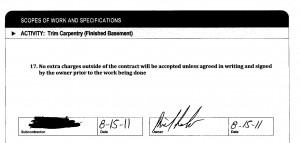Getting Bids for Your Finished Basement, Part II
1 Comment | Posted by armchairbuilder in Basement Finish, Save Money
We’ve been talking about how to go about finishing your basement as an owner-builder. In our last post (Getting Bids for your Finished Basement, part I) we discussed the importance of the bid package and how the bid sheet gives your subcontractors a specific format for submitting a bid. This format allows you to easily review each cost item for the activity and make quick, good decisions based on the information. Here we will discuss the Scopes of Work and Specifications and how they help you get accurate bids. We have also posted a new video discussing the importance of the Scopes of Work and Specifications in your new finished basement project so check it out!
Post continues below the graphic…
We’ve given you a full size copy of the scope of work and specifications for the trim carpentry activity in our finished basement project. There are two main objectives for the scopes of work and specifications. First, we define the work that is to be done. In other words, we tell the subcontractor what we want them to do. This allows them to properly estimate and bid the project. In our trim carpentry example here we tell the trade what items they are required to provide like nails, glue, labor…etc. We also tell them what items they will be installing from casing to extension jambs. The more accurate we are in our description of what we expect, the more accurate the bid will be. You really don’t want to come back later and say to your subcontractor…”oh, and by the way, I forgot to mention…” If you do, you will get additional late costs and fees from the sub that will wreak havoc with your budget.
The second major objective of the scopes of work and specifications is to outline the quality you expect. In our example, we tell the trim carpenter where we want the door shimmed and how high off of the floor to set the door. We also let them know we expect them to protect all other work and to clean up at the end of the activity. Basically, we highlight the most important quality initiatives. I have created these documents from years of building and remodeling homes. At the end of each project, I would re-evaluate the scopes to make sure they had everything we needed to avoid problems.
Below is the second page of the scope of work and specifications for trim carpentry for our finished basement. Number seventeen is probably the most important item. We need to make sure all subcontractors tell us if they experience any unexpected items that will cost us extra money before the work is done. We cannot, and will not accept an invoice after the work is done that adds on additional items if we haven’t previously acknowledged and agreed to the extra cost in writing. This way, we can evaluate the extra charge before the work is done to check for validity and to see if we want to take another course of action.
The last important item is the signature and date of your subcontractor. By signing, the trade acknowledge they agree to the terms and will perform in this way. I can’t tell you how many times I have had to pull out a scope of work and specification to remind a subcontractor during a job what type of quality is required. There really is no argument if it’s in writing and they signed it.
1 Comment for Getting Bids for Your Finished Basement, Part II
Ernest Jeannette | November 1, 2011 at 9:07 pm




Wow, fantastic blog layout! How long have you been blogging for? you made blogging look easy. The overall look of your web site is fantastic, as well as the content!